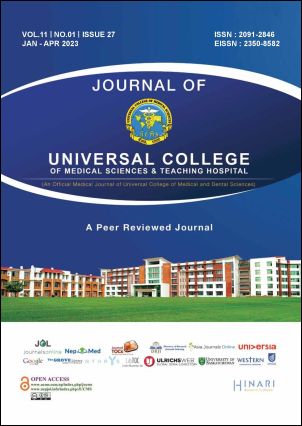Utility of Mannheim’s Peritonitis Index in Predicting Outcome of Peritonitis in Patients with Hollow Viscous Perforation
DOI:
https://doi.org/10.3126/jucms.v11i01.54628Keywords:
Peritonitis, Mannheim’s peritonitis index, Hollow viscous perforationAbstract
INTRODUCTION
Peritonitis due to hollow viscous perforation is one of the common causes for emergency surgery requiring immediate surgical intervention. Scoring systems that provide objective descriptions of the patient’s conditions at specific points in the disease process aid our understanding of these problems. Hence this study is undertaken to study the effectiveness of Mannheim’s peritonitis index in predicting the outcome in peritonitis patient.
MATERIAL AND METHODS
This study was carried out in Department of Surgery of National Medical College and Teaching Hospital. A total of 44 patients with diagnosis of peritonitis due to hollow viscous perforation over period 2 years was included in this study. History and detailed clinical examination were performed as per the working proforma. Blood investigation was done. Data analysis was done using SPSS (Statistical Package for social sciences) version 25.
RESULTS
In this study 44 cases of peritonitis due to hollow viscous perforation were included. The mean age of patients was 38.16 ± 21.09 years. Abdominal pain and abdominal distension were most common presentation. MPI scoring system done in all patients depending on preoperative and intra-operative and patients were categorized into three categories, <21, 21 to 29, and >29 where 50% of patients had MPI less than 21, 25% of patient had MPI score 21-29 and 25% of patient had MPI score >29.
CONCLUSION
MPI scoring system is required to predict the outcome in peritonitis patients and whether the line of management taken is appro- priate or needs to be changed.
Downloads
Downloads
Published
How to Cite
Issue
Section
License
Copyright (c) 2023 Journal of Universal College of Medical Sciences

This work is licensed under a Creative Commons Attribution-NonCommercial 4.0 International License.
Authors have to give the following undertakings along with their article:
- I/we declare that this article is original and has not been submitted to another journal for publication.
- I/we declare that I/we surrender all the rights to the editor of the journal and if published will be the property of the journal and we will not publish it anywhere else, in full or part, without the permission of the Chief Editor.
- Institutional ethical and research committee clearance certificate from the institution where work/research was done, is required to be submitted.
- Articles in the Journal are Open Access articles published under the Creative Commons CC BY-NC License (https://creativecommons.org/licenses/by-nc/4.0/)
- This license permits use, distribution and reproduction in any medium, provided the original work is properly cited, and it is not used for commercial purposes.




